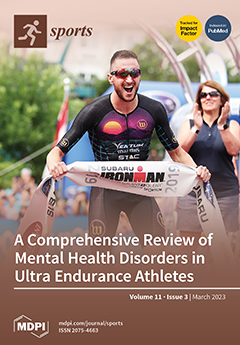Oral pathologies can cause athletic underperformance. The aim of this study was to determine the effect of malocclusion on maximal aerobic capacity in young athletes with the same anthropometric data, diet, training mode, and intensity from the same athletics training center. Sub-elite track
[...] Read more.
Oral pathologies can cause athletic underperformance. The aim of this study was to determine the effect of malocclusion on maximal aerobic capacity in young athletes with the same anthropometric data, diet, training mode, and intensity from the same athletics training center. Sub-elite track and field athletes (middle-distance runners) with malocclusion (experimental group (EG); n = 37; 21 girls; age: 15.1 ± 1.5 years) and without malocclusion (control group (CG); n = 13; 5 girls; age: 14.7 ± 1.9 years) volunteered to participate in this study. Participants received an oral diagnosis to examine malocclusion, which was defined as an overlapping of teeth that resulted in impaired contact between the teeth of the mandible and the teeth of the upper jaw. Maximal aerobic capacity was assessed using the VAMEVAL test (calculated MAS and estimated VO
2max). The test consisted of baseline values that included the following parameters: maximum aerobic speed (MAS), maximal oxygen uptake (VO
2max), heart rate frequency, systolic (SAP) and diastolic arterial pressure (DAP), blood lactate concentration (LBP), and post-exercise blood lactate assessment (LAP) after the performance of the VAMEVAL test. There were no statistically significant differences between the two study groups related to either anthropometric data (age: EG = 15.1 ± 1.5 vs. CC = 14.7 ± 1.9 years (
p = 0.46); BMI: EG = 19.25 ± 1.9 vs. CC = 19.42 ± 1.7 kg/m
2 (
p = 0.76)) or for the following physical fitness parameters and biomarkers: MAS: EG = 15.5 (14.5–16.5) vs. CG = 15.5 (15–17) km/h (
p = 0.47); VO
2max: EG = 54.2 (52.5–58.6) vs. CG = 54.2 (53.4–59.5) mL/kg/min (
p = 0.62) (IQR (Q1–Q3)); heart rate before the physical test: EG = 77.1 ± 9.9 vs. CG = 74.3 ± 14.0 bpm (
p = 0.43); SAP: EG = 106.6 ± 13.4 vs. CG = 106.2 ± 14.8 mmHg (
p = 0.91); DAP: EG = 66.7 ± 9.1 vs. CG = 63.9 ± 10.2 mmHg (
p = 0.36); LBP: EG = 1.5 ± 0.4 vs. CG = 1.3 ± 0.4 mmol/L (
p = 0.12); and LAP: EG = 4.5 ± 2.36 vs. CG = 4.06 ± 3.04 mmol/L (
p = 0.60). Our study suggests that dental malocclusion does not impede maximal aerobic capacity and the athletic performance of young track and field athletes.
Full article






